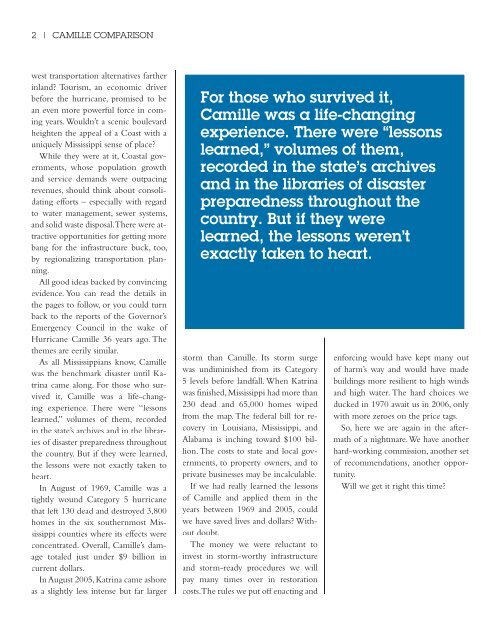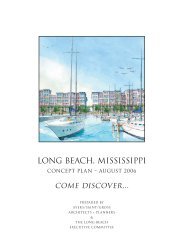Reports - Mississippi Renewal
Reports - Mississippi Renewal
Reports - Mississippi Renewal
- No tags were found...
Create successful ePaper yourself
Turn your PDF publications into a flip-book with our unique Google optimized e-Paper software.
2 | CAMILLE COMPARISONwest transportation alternatives fartherinland? Tourism, an economic driverbefore the hurricane, promised to bean even more powerful force in comingyears. Wouldn’t a scenic boulevardheighten the appeal of a Coast with auniquely <strong>Mississippi</strong> sense of place?While they were at it, Coastal governments,whose population growthand service demands were outpacingrevenues, should think about consolidatingefforts – especially with regardto water management, sewer systems,and solid waste disposal. There were attractiveopportunities for getting morebang for the infrastructure buck, too,by regionalizing transportation planning.All good ideas backed by convincingevidence. You can read the details inthe pages to follow, or you could turnback to the reports of the Governor’sEmergency Council in the wake ofHurricane Camille 36 years ago. Thethemes are eerily similar.As all <strong>Mississippi</strong>ans know, Camillewas the benchmark disaster until Katrinacame along. For those who survivedit, Camille was a life-changingexperience. There were “lessonslearned,” volumes of them, recordedin the state’s archives and in the librariesof disaster preparedness throughoutthe country. But if they were learned,the lessons were not exactly taken toheart.In August of 1969, Camille was atightly wound Category 5 hurricanethat left 130 dead and destroyed 3,800homes in the six southernmost <strong>Mississippi</strong>counties where its effects wereconcentrated. Overall, Camille’s damagetotaled just under $9 billion incurrent dollars.In August 2005, Katrina came ashoreas a slightly less intense but far largerFor those who survived it,Camille was a life-changingexperience. There were “lessonslearned,” volumes of them,recorded in the state’s archivesand in the libraries of disasterpreparedness throughout thecountry. But if they werelearned, the lessons weren’texactly taken to heart.storm than Camille. Its storm surgewas undiminished from its Category5 levels before landfall. When Katrinawas finished, <strong>Mississippi</strong> had more than230 dead and 65,000 homes wipedfrom the map. The federal bill for recoveryin Louisiana, <strong>Mississippi</strong>, andAlabama is inching toward $100 billion.The costs to state and local governments,to property owners, and toprivate businesses may be incalculable.If we had really learned the lessonsof Camille and applied them in theyears between 1969 and 2005, couldwe have saved lives and dollars? Withoutdoubt.The money we were reluctant toinvest in storm-worthy infrastructureand storm-ready procedures we willpay many times over in restorationcosts. The rules we put off enacting andenforcing would have kept many outof harm’s way and would have madebuildings more resilient to high windsand high water. The hard choices weducked in 1970 await us in 2006, onlywith more zeroes on the price tags.So, here we are again in the aftermathof a nightmare. We have anotherhard-working commission, another setof recommendations, another opportunity.Will we get it right this time?




